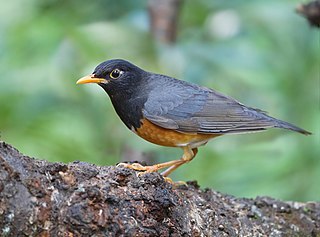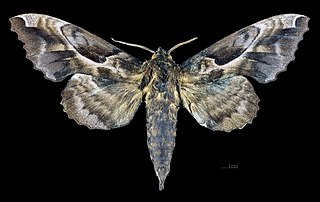
Papilio clytia, the common mime, is a swallowtail butterfly found in south and southeast Asia. The butterfly belongs to the subgenus Chilasa, the black-bodied swallowtails. It serves as an excellent example of a Batesian mimic among the Indian butterflies.

The hooded parrot is a species of parrot native to the Northern Territory in Australia. It is found in savannah and open woodland and is one of two extant species in its genus that breed in termite mounds. It has declined from much of its original range.

The black-breasted thrush is a species of bird in the family Turdidae. It is found from north-eastern India to northern Vietnam. Although both male and female birds have the same colour on their lower parts, the upper section of males is mostly black in colour, while females are mostly grey-brown. Thus, the bird's common name refers to the colour of the male bird's breast. They tend to live in forests located at high altitude.

Phyllosphingia is a monotypic moth genus in the family Sphingidae erected by Charles Swinhoe in 1897. Its only species, Phyllosphingia dissimilis, the buff-leaf hawkmoth, was described by Otto Vasilievich Bremer in 1861.
Catocala dissimilis is a moth of the family Erebidae. It is found in Russia, China, Korea and Japan.
The streamline chub is one of the 324 fish species found in Tennessee.

Anastrangalia is a genus of beetle in the family Cerambycidae, containing the following species:

Anastrangalia dubia is a species of beetle of family Cerambycidae.
Anastrangalia laetifica is a species of beetle from family Cerambycidae found in Canada, United States, and Mexico. The females are all black, while the males have 4 black dots on their red coloured elytra. They feed on Frasera albicaulis.
Anastrangalia dissimilis is a species of beetle from family Cerambycidae.
Anastrangalia reyi is a species of beetle from family Cerambycidae found in such European countries as Austria, Belarus, Czech Republic, Finland, France, Germany, Italy, Liechtenstein, Norway, Poland, Russia, Slovakia, Sweden, Ukraine, and the Baltic states. The species could also be found in Asian countries such as China, Japan, Kazakhstan, and Mongolia.
Anastrangalia reyi reyi is a subspecies of beetle from family Cerambycidae, that can be found in such European countries as Austria, Belarus, Czech Republic, Finland, France, Germany, Italy, Poland, Slovakia, Sweden, Switzerland, Ukraine, and the Baltic states.
Anastrangalia reyi sequensi is a subspecies of beetle from the family Cerambycidae, that can be found in such Asian countries as China, Japan, Kazakhstan, and Mongolia. The species have brown pronotum.
Anastrangalia kasaharai is a species of beetle from family Cerambycidae that is endemic to Japan. The species are either black or red coloured.
Anastrangalia scotodes is a species of beetle from family Cerambycidae. They live especially in Africa.
Anastrangalia sanguinea is a species of beetle from family Cerambycidae.
Anastrangalia rubriola kashmirica is a species of beetle from family Cerambycidae.
Heteronygmia dissimilis is a species of moth in the subfamily Lymantriinae first described by Per Olof Christopher Aurivillius in 1910. It is native to Africa. The adult moth is on wing from February to November, but is most common between June and September. The larvae feed on the foliage of the East African mahogany and when they are plentiful, they can defoliate the tree.

Aponotoreas dissimilis is a moth of the family Geometridae. It is endemic to New Zealand.
Euamiana dissimilis is a species of moth in the family Noctuidae. It was first described by William Barnes and James Halliday McDunnough in 1910 and it is found in North America.






